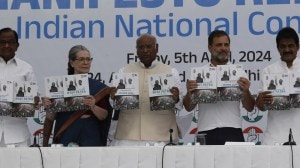- India
- International
Hardlook — Public transport: Bus stopped
20 years after the Supreme Court said the capital must have at least 10,000 buses, the figures remain woefully short of target. With bolstering public transport being one of AAP’s major poll promises, The Indian Express looks at how the government plans to address the shortfall
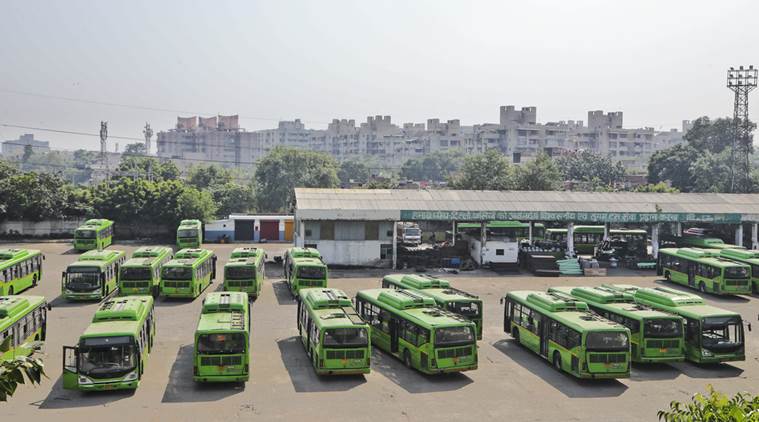 Data shared by DTC with the transport department is telling: Out of its current 464 routes, buses don’t run on five; around 75 routes. (Express photo by Abhinav Saha)
Data shared by DTC with the transport department is telling: Out of its current 464 routes, buses don’t run on five; around 75 routes. (Express photo by Abhinav Saha)
Around 2 pm on a Saturday, traffic in west Delhi’s Dwarka Mor junction is bursting at the seams — cars, buses, e-rickshaws, vans ferrying school children and a few stray cows jostle for space. Above, trains enter and exit the Metro station in clockwork precision. A little over 15 km away, the road cutting through Najafgarh’s Nanak Heri village is deserted, save for a group of women walking towards Chhawla, a settlement 5 km away. At neighbouring Shikarpur, men sit on their haunches and wait for the next gramin sewa to Najafgarh town, 6 km from Dwarka Mor.
“Ye samajh lijiye, hum ye bhool gaye ki DTC bus dikhti kaisi hai (the situation is such that we have forgotten what a DTC bus looks like),” said Rohtas, sitting outside 73-year-old Shri Gopal’s sweet shop at Nanak Heri. On the face of it, his assertion may sound a little exaggerated, but the village has officially fallen off the Delhi Transport Corporation’s map owing to its depleting bus fleet over the years.
Data shared by DTC with the transport department is telling: Out of its current 464 routes, buses don’t run on five; around 75 routes, including Shikarpur, are served by one bus each; and nearly half (230 routes) have one to five buses catering to people.
The cluster services, managed by the Delhi Integrated Multi-Modal Transit System (DIMTS), is doing no better. Around 40 of its 147 routes are served by one to five buses each. In the case of both DTC and DIMTS, the severely under-served routes mostly connect outer Delhi areas such as villages in southwest Delhi’s Najafgarh, Narela, Bawana or far-off areas like Kanjhawala, Loni, Nand Nagri and Qutabgarh.
Read | Delhi: Four bus terminals to get facelift by next year under pilot project

Gopal, a retired DTC bus driver, recounted how buses on route number 834, between Nanak Heri and Tilak Nagar, used to undertake multiple trips until a few years ago. “The number of trips kept reducing gradually. Now we are completely at the mercy of gramin sewa vehicles,” he said.
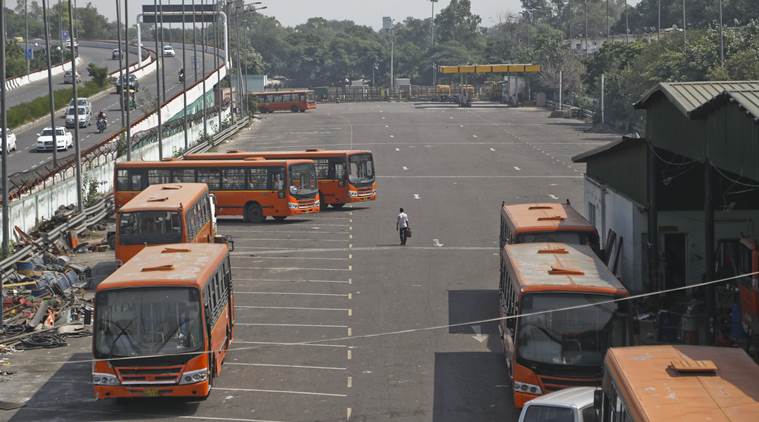 The cluster services, managed by the Delhi Integrated Multi-Modal Transit System (DIMTS), is doing no better. (Express photo by Abhinav Saha)
The cluster services, managed by the Delhi Integrated Multi-Modal Transit System (DIMTS), is doing no better. (Express photo by Abhinav Saha)
Shikarpur farmer Pawan Tyagi said gramin sewa autos charge Rs 15 for trips to Najafgarh, which houses a terminal from where buses leave for areas like Uttam Nagar, Narela and Central Secretariat. “It’s a daily struggle for those who don’t own private vehicles. I find it hard to believe that I’m a resident of the country’s capital,” Tyagi rued, sitting on a charpoy in his mustard farm, with distant highrises in Gurgaon forming the backdrop.
Multiple studies, no solution
In 2011, the Sheila Dikshit government had for the first time in Delhi attempted to assess the demand and supply of buses across the then prevailing routes by commissioning a study through DIMTS. But the recommendations gathered dust over the years, said Anumita Roy Chowdhury, Executive Director-Research and Advocacy at the Centre for Science and Environment (CSE).
“Based on our interviews with some DTC officials in the past, we understand that basic fleet allocation tweaks are done manually based on periodic reviews of earnings data on routes… A large-scale route rationalisation exercise was last done in 2011 by DIMTS, whose recommendations weren’t implemented largely,” said Roy Chowdhury, who led a comprehensive CSE study on Delhi’s buses.
In July, the AAP government launched ‘Delhi Connect’, a similar exercise, also through DIMTS. Transport Minister Kailash Gahlot had said the study was being carried out to ensure frequent, reliable and affordable public transport facilities within 500 metres of any household.
Jasmine Shah, advisor to Gahlot, said the Najafgarh-end of the study was complete and a pilot project will be launched by November, under which many villages in the area will come under the public bus network for the first time.
“Some members of the DIMTS team are going door-to-door to understand daily travel patterns. A few are talking to people on buses, some are stationed at bus terminals and Metro stations, while a specialised team is looking at GPS data of public vehicles to map demand. The study should be complete by December,” he said.
Accordingly, the bus fleet will be rearranged into a trunk and feeder system where long-distance routes will have buses available in high-frequency. The feeder routes, in turn, will connect these high-frequency corridors to every neighbourhood, Shah, a public policy graduate from Columbia University, added.
Gahlot told The Indian Express that 70 new buses will be added in routes serving Najafgarh under the scheme.
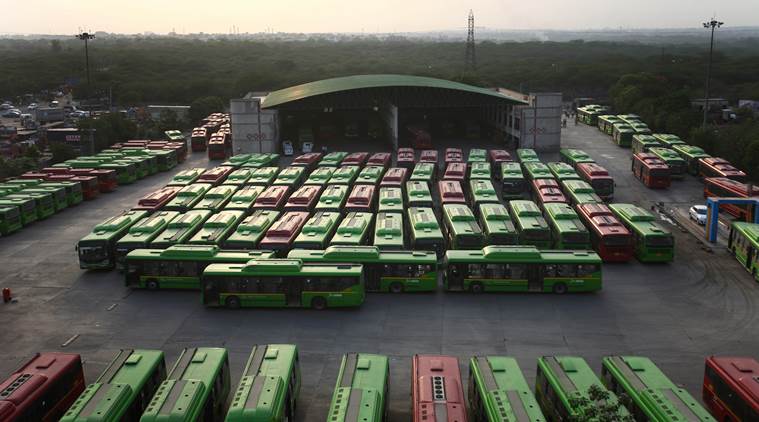 According to DTC’s operational statistics, in 2010-11 and 2012-13, over 44.2 and 46 lakh people respectively used to take buses daily. (Express photo by Oinam Anand)
According to DTC’s operational statistics, in 2010-11 and 2012-13, over 44.2 and 46 lakh people respectively used to take buses daily. (Express photo by Oinam Anand)
Tender issues
In 1998, when Delhi was in the grip of a pollution emergency, the Supreme Court had directed the state government to augment its bus fleet to at least 10,000 and convert the entire public vehicle fleet to CNG. While it was eventually converted to CNG, the bus fleet could never attain the magic figure of 10,000. The figure was recently revised to 11,000.
Two DTC tenders, floated in 2006 and 2008, got through successfully and the corporation procured 3,775 low-floor buses. Since then, around five tenders for a total of 5,730 buses between 2008 and 2018 have failed. To tide over the crisis, the Congress government launched the cluster services scheme in May 2011. Under this, private operators procure and run buses and are paid by the government on a per-kilometre basis. This model met with some success and as of today, 1,648 standard-floor orange buses run in nine clusters. This, along with the DTC’s 3,781 buses, takes the total to 5,429 — a shortfall of over 5,500 buses.
The Centre’s JNNURM programme fixed a number of 50 buses per lakh population for cities with a population of over 40 lakh. The Ministry of Housing and Urban Affairs pegs the figure at 60 buses per lakh population.
Referring to London which, with over 8,000 buses for its 80 lakh population, is considered the global benchmark in terms of bus strength, Shah said ideally there should be one bus per 1,000 people. Among other global cities, Beijing has over 24,000 buses for its 2 crore population; 4,000 buses cater to Paris’s 20 lakh people; and over 10,000 buses serve Hong Kong’s population of around 70 lakh.
“There has to be an independent mechanism for annual review of fleet requirement at the level of DTC, wherein based on the number of buses likely to be phased out in the coming year and the target fleet size to be maintained, a requisition can be sent to the state government to purchase buses every year. Based on our understanding, this has been missing in Delhi,” said Roy Chowdhury.
In fact, the situation is more alarming than it appears. The average age of DTC buses, according to the corporation’s operational statistics, is around 6.2 years, less than the scrapping period of 12 years or 7.5 lakh km travelled as mentioned in the tenders. Going by the ground average, a staggering 70% of the existing buses are already four-six years old; around 700 are six-eight years old; while over 500 are over 10 years old — figures highlighting that an immediate augmentation of the bus fleet is imperative.
* According to a status report filed by the transport department in the SC, a 2008 tender for 750 non-AC, semi- low-floor buses and 250 AC semi- low-floor buses was cancelled as the rates quoted by Ashok Leyland were on the “higher side”.
* A 2013 tender for 500 non-AC low-floor buses was scrapped due to “unrealistic, exorbitantly high, unreasonable and unjustifiable” rates quoted for AMC (annual maintenance clause), while no bid was received for 125 AC low-floor buses.
* Another tender for 1,380 non-AC semi- low-floor buses was foreclosed in the same year as only one player came forward.
* In 2014, a tender for 1,380 non-AC semi- low-floor buses was also foreclosed due to “very high price of bus and AMC charges quoted by Tata Motors”.
* The last tender, for 1,000 standard-floor buses, also failed in May this year as only Tata Motors came up.
Transport Commissioner Varsha Joshi said this happened despite the AMC clause being scrapped from the tender. Shah added that the DTC used to have the AMC clause in its tenders, as it did not have the requisite technical expertise to maintain low-floor buses.
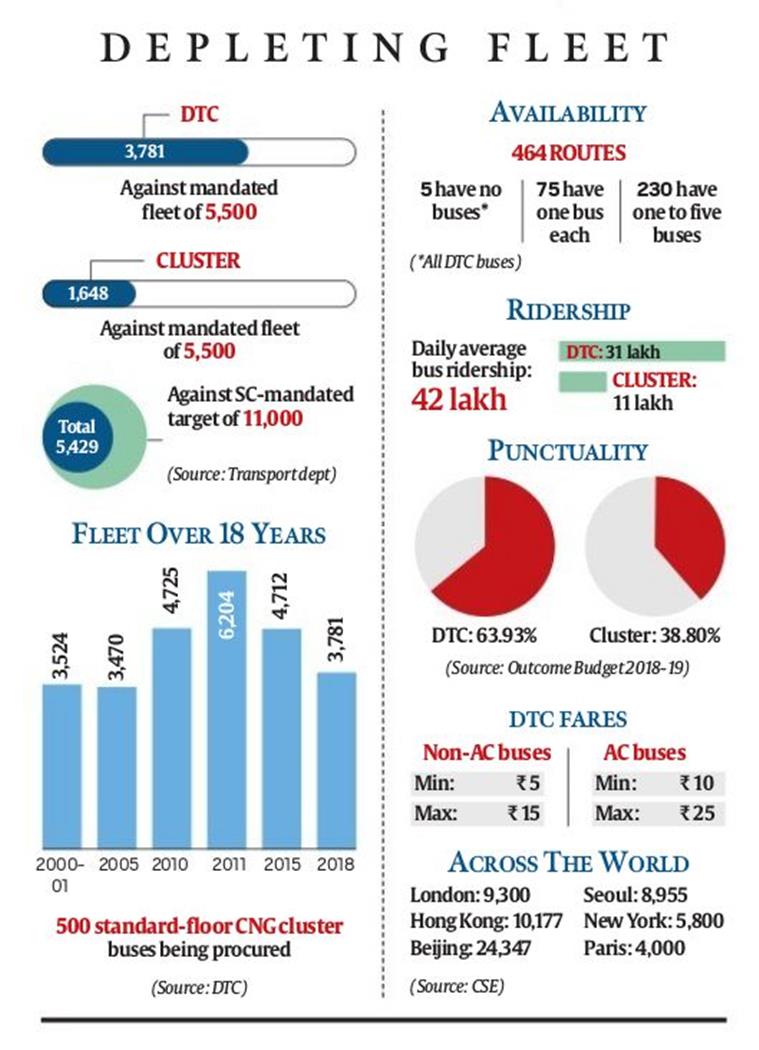
Drop in ridership
Meanwhile, DTC ridership, at 31 lakh daily, has plummeted to 2010 levels. Cluster services are availed by another 11.42 lakh people, according to the government’s outcome budget.
According to DTC’s operational statistics, in 2010-11 and 2012-13, over 44.2 and 46 lakh people respectively used to take buses daily. The slide began in 2013-14 with the gradual decline in the number of buses. The corporation had 6,204 buses in 2010-11, which included the standard-floor ‘Blueline’ buses that caused multiple casualties.
The subsequent slide has still not been arrested. The corporation’s fares have also remained frozen since 2009. In 2017-18, its operating cost and earnings per km were Rs 92 and Rs 31 respectively.
In successive meetings of the DTC board, now chaired by Gahlot, the Delhi Finance Department has been pushing for fare revision to revive the corporation. But experts opine that any fare revision could be counter-productive.
“From an affordability perspective, our analysis has found that almost 34% of Delhi’s population cannot use the basic non-AC DTC buses as it is unaffordable, while AC buses, until DMRC’s fare hike, were costlier than Metro itself. DTC needs a fiscal strategy to reduce its own costs and mobilise its own non-fare resources,” said Roy Chowdhury.
Way forward
In its early days, the AAP government complained that not having land under its jurisdiction was coming in the way of constructing new bus depots — a pre-requisite for strengthening its bus fleet. The SC EPCA has submitted in court that around 134 acres of additional land was required to house as many as 11,000 buses. However, it also added that the government owns enough land presently to provide parking to 2,000 buses.
“What we often forget is that the total bus depot capacity added under the AAP since 2015 is 41% of what was added in the decades before,” said Shah. According to transport department data, until 2015, DTC depots could house 4,050 buses, while depots for cluster buses could accommodate 1,715.
With the addition of depots in Ghumanhera and Mundhela Kalan, 460 more DTC buses can be housed now, while 11 new depots with a capacity to shelter 1,906 buses will be ready by early next year. A bus depot of five acres can house 120 buses, including a workshop, said EPCA.
Meanwhile, on October 5, the government issued letters of acceptance to two private vendors to operate 500 standard-floor buses fitted with hydraulic lifts in two new clusters, in line with clearance from the SC. Gahlot said the buses shall start hitting the roads within the next two to four months.
The DTC, on the other hand, is exploring the possibility of running 1,000 low-floor buses on a “joint-ownership model” involving private players. “The tenders have failed over the years as vendors have quoted exorbitantly high AMC costs. So we are exploring this model. The standing counsel has given a favourable opinion. It will be cleared by the Cabinet,” Gahlot said.
The DIMTS has been appointed as a consultant to help execute another ambitious proposal to procure 1,000 electric buses. It is expected to submit its report in a month, the minister said. With the 2019 Lok Sabha elections approaching, the government is running against time as work will come to a halt once the Model Code of Conduct for polls comes into force, which will rule out the chances of floating new tenders and launching new projects.
Apr 25: Latest News
- 01
- 02
- 03
- 04
- 05


















